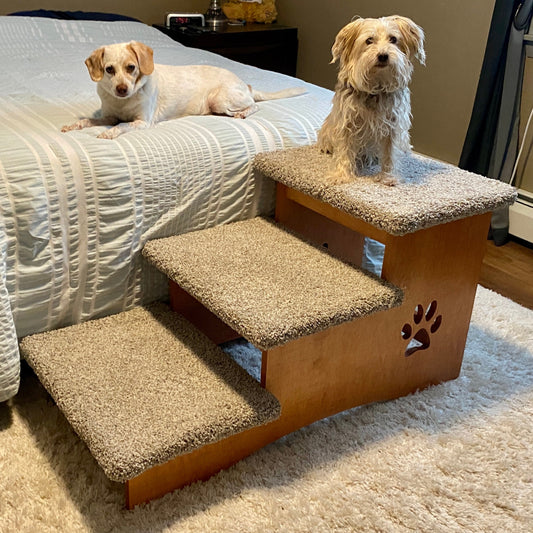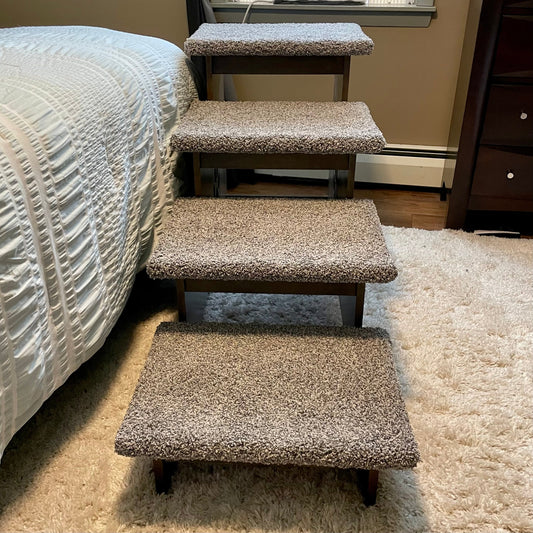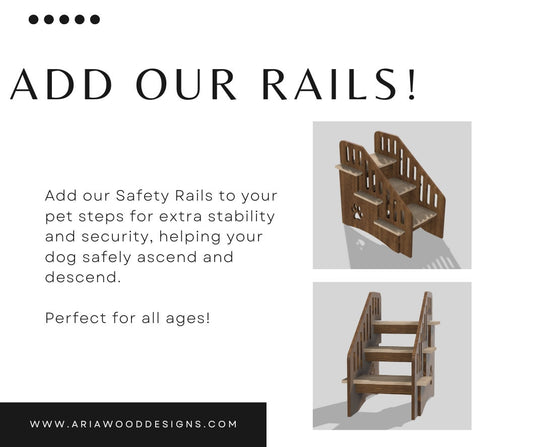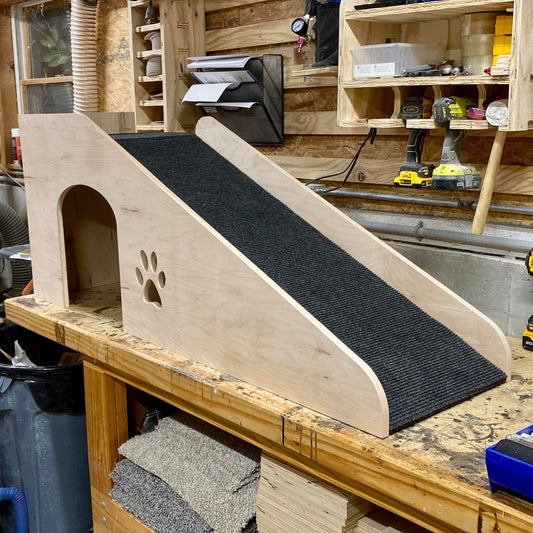Your furry companion deserves the best support as they navigate their daily routines. When beds, couches, and cars become challenging obstacles rather than cozy destinations, it's time to consider mobility solutions that keep your pet comfortable and independent.
Both dog ramps and stairs serve as valuable tools to help pets access higher surfaces safely. However, choosing between these two options requires understanding your dog's specific needs, physical capabilities, and the unique advantages each solution offers.
This comprehensive guide explores everything you need to know about dog ramps and stairs. We'll examine the benefits of each option, help you determine which solution best suits your pet, and provide practical insights to make an informed decision that enhances your dog's quality of life.
Understanding Dog Mobility Needs
Dogs face various mobility challenges throughout their lives. Puppies may struggle with coordination and strength. Senior dogs often deal with arthritis, hip dysplasia, or general joint stiffness. Even healthy adult dogs can benefit from mobility aids that reduce strain on their joints and prevent future injuries.
Small dog breeds face particular challenges due to their size. A standard couch or bed can represent a significant height obstacle for a Chihuahua or Yorkshire Terrier. Large breeds, while naturally equipped to handle heights, may develop joint issues that make jumping uncomfortable or dangerous.
The key is recognizing when your pet needs support. Signs include hesitation before jumping, visible discomfort after getting up or down, changes in activity levels, or reluctance to access previously favorite spots.
The Case for Dog Ramps
Dog ramps provide a gradual incline that allows pets to walk up and down rather than stepping or jumping. This gentle approach offers several distinct advantages for pet mobility.
Joint Protection and Health Benefits
Ramps significantly reduce impact on joints, making them particularly beneficial for dogs with arthritis, hip dysplasia, or other orthopedic conditions. The gradual incline distributes weight evenly and eliminates the jarring motion associated with jumping.
Senior dogs especially benefit from this low-impact approach. As dogs age, their joints become more sensitive, and repetitive jumping can accelerate wear and damage. A ramp allows them to maintain independence while protecting their long-term joint health.
Ideal for Specific Conditions
Certain medical conditions make ramps the preferred choice. Dogs recovering from surgery, those with back problems, or pets with neurological conditions that affect balance find ramps easier to navigate than stairs.
The continuous surface of a ramp provides stability for dogs who might struggle with the discrete steps of stairs. This makes ramps particularly valuable for dogs with vision problems or balance issues.
Size and Space Considerations
Ramps require more horizontal space than stairs to achieve the same height. This can be both an advantage and a limitation, depending on your living situation. The longer surface area provides more room for pets to position themselves comfortably but may not fit in smaller spaces.
The Benefits of Pet Steps
Pet steps offer a different approach to mobility assistance, providing discrete platforms that dogs can use to climb gradually to higher surfaces.
Natural Movement Patterns
Many dogs find stairs intuitive because the stepping motion aligns with their natural gait. This familiarity can make training easier and reduce the adjustment period when introducing mobility aids.
Steps also provide clear visual and physical boundaries that some dogs find reassuring. Each step represents a manageable goal, making the overall climb feel less daunting.
Space Efficiency
Pet steps typically require less floor space than ramps, making them ideal for smaller homes or apartments. They can often fit neatly beside furniture without dominating the room or creating obstacles for human navigation.
Versatility and Stability
Well-constructed pet steps for both your dog and your cat offer excellent stability and can support dogs of various sizes. The discrete platforms allow dogs to rest between levels if needed, which can be particularly helpful for older or less energetic pets.

Aria Wood Designs
High-quality pet steps that are one of a kind, like those from Aria Wood Designs, feature wide, deep steps that provide ample space for dogs to position their paws securely. The carpeted surfaces offer traction while remaining comfortable for sensitive paw pads.
Comparing Ramps and Steps: Key Factors
Several important factors should guide your decision between ramps and steps for your pet.
Your Dog's Physical Condition
Dogs with severe arthritis, recent injuries, or significant mobility limitations often do better with ramps. The gentle incline reduces stress on joints and eliminates the need to lift legs to specific heights.
However, dogs with good joint health who simply need assistance with height may thrive with steps. The discrete platforms can actually provide exercise benefits by encouraging controlled movement.
Age and Training Considerations
Puppies and young dogs typically adapt quickly to either option. However, senior dogs who have never used mobility aids may find one option more intuitive than the other.
Some older dogs resist ramps initially because the incline feels unstable or unfamiliar. Others prefer ramps because they don't require the coordination needed for steps. Observing your dog's natural preferences and comfort level guides the best choice.
Home Environment and Aesthetics
Your living space plays a crucial role in determining the most practical option. Ramps require more floor space and may not fit well in compact areas. Steps offer more flexibility in placement and often blend better with home decor.
Consider where you'll place the mobility aid most frequently. Bedroom access might favor compact steps, while accessing a deck or car might work better with a ramp.
Long-term Value and Durability
Both ramps and steps represent investments in your pet's long-term comfort and health. High-quality options last for years and adapt to changing needs as your pet ages.
Consider your dog's likely future needs. A young, healthy dog might do well with steps initially but may benefit from a ramp as they age. Some pet owners find value in having both options available for different situations.
Choosing the Right Height and Size
Proper sizing ensures safety and effectiveness for any mobility aid you choose.
Measuring for Success
Start by measuring the height your pet needs to reach. Common heights include 14 inches for standard couches, 20-23 inches for most beds, and 30 inches for higher beds or SUV cargo areas.
Also consider your dog's size and stride length. Large dogs need wider steps or ramps to accommodate their broader stance, while small dogs may prefer narrower options that feel more secure.
Safety Guidelines
For ramps, the ideal angle depends on your dog's condition and comfort level. A gentler slope (longer ramp) is always safer than a steep incline, even if it requires more space.
For steps, ensure each platform is deep enough for your dog's paws. Small dogs need at least 6-8 inches of depth, while large dogs require 10-12 inches or more. The height between steps should allow comfortable stepping without strain.
Material Quality and Construction
The construction quality of pet mobility aids directly impacts safety, durability, and long-term value.
Wood vs. Other Materials
Solid wood construction offers superior durability and stability compared to plastic or foam alternatives. Wood steps and ramps can support heavier dogs without flexing or becoming unstable.
High-quality wooden pet steps feature reinforced construction with techniques like pocket-hole joinery, which creates exceptionally strong connections between components. This advanced construction method ensures the steps remain stable even with daily use by active pets.
Surface Materials and Traction
The surface material significantly affects your pet's comfort and confidence. Carpeted surfaces provide excellent traction while remaining gentle on paw pads.
Pet-friendly carpeting should resist stains and odors while maintaining its texture over time. Some surfaces are specifically designed to be easily cleanable, which is essential for maintaining hygiene and appearance.
Assembly and Maintenance
Look for products that arrive with pre-drilled holes and clear assembly instructions. Quality manufacturers provide all necessary hardware and tools, making setup straightforward for pet owners.
Consider long-term maintenance requirements. Solid wood construction with quality finishes requires minimal upkeep while maintaining appearance and function over years of use.
Training Your Dog to Use Mobility Aids
Successfully introducing ramps or steps requires patience and positive reinforcement.
Initial Introduction
Start by placing the mobility aid in position without forcing your dog to use it. Allow them to investigate and become familiar with the new addition to their environment.
Use treats and praise to create positive associations. Place treats on different levels of steps or along the ramp to encourage exploration.
Building Confidence
Begin training during calm periods when your pet is relaxed but motivated by treats or attention. Avoid forcing or rushing the process, as negative experiences can create lasting reluctance.
Some dogs take to mobility aids immediately, while others need several days or weeks to feel completely comfortable. Consistency and patience yield the best results.
Addressing Common Challenges
Dogs who resist using mobility aids often have concerns about stability or unfamiliar textures. Address these issues by ensuring the aid is properly positioned and secure.
If your dog continues to jump despite having access to the mobility aid, temporarily block their usual jumping route while redirecting them to the steps or ramp. Consistent redirection helps establish new habits.
Special Considerations for Different Dog Types
Various factors influence which mobility solution works best for different types of dogs.
Small Dogs and Toy Breeds
Small dogs often prefer steps because the discrete platforms feel more secure than a potentially wobbly ramp surface. However, the steps must be appropriately sized—standard human-sized steps are often too deep for tiny paws.
Look for steps designed specifically for small dogs, with platform depths of 6-8 inches and step heights of 4-6 inches. This sizing allows comfortable movement without requiring excessive stretching or awkward positioning.
Large and Giant Breeds
Large dogs need robust construction to safely support their weight. Both ramps and steps must be engineered for heavy-duty use with wide surfaces and reinforced connections.
Extra-deep steps work particularly well for large breeds, providing ample space for their bigger paws and broader stance. Platforms should be at least 12 inches deep for comfortable positioning.
Senior Dogs with Mobility Issues
Older dogs with arthritis or other mobility limitations often benefit most from ramps, which eliminate the need to lift legs to specific heights. However, some senior dogs prefer the security of steps if their balance remains good.
Consider your senior dog's specific limitations. Dogs with hip problems may prefer ramps, while those with mild arthritis but good balance might do well with appropriately sized steps.
Dogs with Visual Impairments
Dogs with vision problems often prefer steps because the discrete edges provide clear tactile feedback about their position. The defined platforms help visually impaired dogs figure out how to navigate confidently.
Ensure steps have consistent dimensions so your dog can learn the pattern and navigate predictably. Ramps can work for visually impaired dogs but may require more training to establish confidence.

Cost Considerations and Long-term Value
Investing in quality pet mobility aids provides long-term benefits that often justify higher initial costs.
Initial Investment vs. Long-term Benefits
High-quality wooden steps or ramps cost more initially than basic plastic alternatives but provide superior durability, stability, and longevity. Well-constructed wooden products often last the lifetime of your pet with minimal maintenance.
Consider the long-term veterinary costs associated with joint injuries from jumping. Mobility aids that prevent these injuries provide significant value beyond their purchase price.
Customization and Sizing Options
Many manufacturers offer customization options for height, width, and finish to match specific needs and home decor. While custom options cost more, they ensure perfect fit and function for your situation.
Standard sizes work well for many pets and situations, but custom sizing may be worthwhile for unusual heights or specific space constraints.
Making Your Decision
Choosing between ramps and steps ultimately depends on your dog's individual needs, your living situation, and your long-term plans.
Consider your dog's current physical condition, age, and likely future needs. A young, healthy dog might do well with steps initially, while an older dog with joint issues may benefit more from a ramp.
Evaluate your space constraints and aesthetic preferences. Both options can be beautiful and functional, but one may fit better in your specific environment.
Think about your dog's personality and preferences. Some dogs immediately take to mobility aids, while others need more encouragement. Choosing an option that aligns with your dog's natural inclinations increases the likelihood of successful adoption.

Helpful Resources for Dog Hip Issues and Pet Mobility
Below is a list of 7 highly useful links and resources to help you understand and address dog hip issues, as well as explore how pet ramps can provide relief:
-
American Kennel Club (AKC) - Canine Hip Dysplasia
Learn about hip dysplasia, its causes, symptoms, and treatment options directly from the AKC.
Visit AKC's guide on canine hip dysplasia -
Veterinary Partner - Hip Dysplasia in Dogs
A trusted resource offering in-depth information about the condition, medical interventions, and preventive care.
Explore Veterinary Partner's article on hip dysplasia -
Orthopedic Foundation for Animals (OFA)
This organization provides information on canine orthopedic health, including programs for hip dysplasia screenings.
Learn more at the OFA website -
Pets WebMD - Caring for a Dog with Hip Problems
Discover practical tips for improving mobility and comfort for dogs suffering from hip issues.
Read WebMD's guide for dogs with hip problems -
Canine Arthritis Management (CAM)
A resource dedicated to managing arthritis and joint conditions in dogs, with recommendations for ramps and other tools.
Visit Canine Arthritis Management -
Tufts University's Cummings School of Veterinary Medicine
Access expert insights and articles about managing canine mobility issues and preventing injuries.
Access Tufts University veterinary articles
These resources will equip you with the knowledge and tools to support your pet's mobility and manage hip-related issues effectively.
Enhancing Your Pet's Quality of Life
The right mobility solution does more than provide access to furniture—it maintains your dog's independence and confidence while protecting their long-term health.
Quality pet steps or ramps become integral parts of your home, supporting your pet's daily routines for years to come. The investment in your pet's comfort and health pays dividends in their continued happiness and your peace of mind.
Whether you choose steps or a ramp, selecting a well-constructed product from a reputable manufacturer ensures safety, durability, and long-term satisfaction. Your pet deserves the best support as they navigate their daily adventures, and the right mobility aid provides exactly that.
Consider exploring high-quality options that combine superior construction with thoughtful design. Well-crafted pet steps you'll love, like those offered by Aria Wood Designs, represent the perfect blend of functionality, durability, and aesthetic appeal that both you and your pet will appreciate for years to come.









